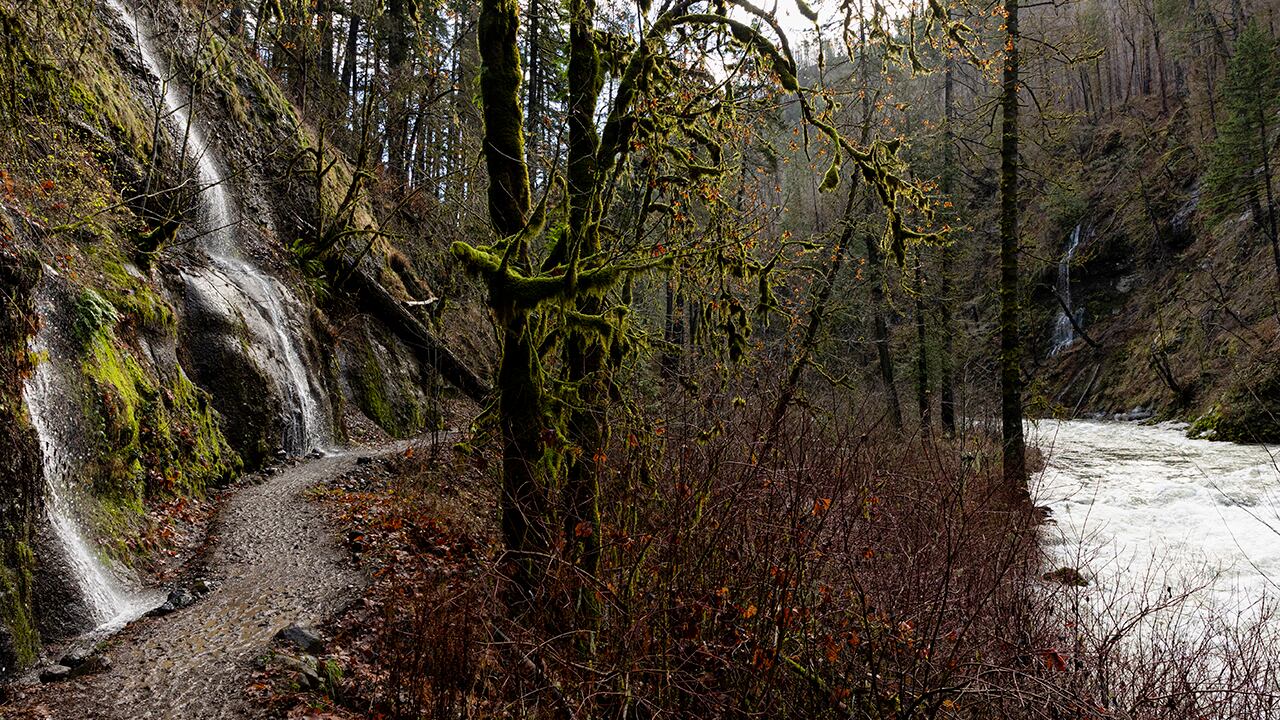Like many Oregonians, Morgan Bailey looked forward to hiking the Eagle Creek Trail after it reopened from wildfire damage. So he was disappointed to find it closed by washouts last month.
But that was far from the low point of his Jan. 19 trip to the woods. Bailey tried the next trail up the Columbia River Scenic Highway, a path he believes was Gorton Creek Trail #408.
Then he got lost.
Bailey, 43, was three miles up the trail when it disappeared on him. He spent the next three days scrambling across cliff faces through half-burnt forest. On Jan. 22, two hikers found him, bleeding and hypothermic.
Search and rescue crews described his ordeal as a cautionary tale of hiking the Gorge alone and with few supplies, especially in winter. "He was extremely fortunate," said Hood County sheriff's deputy Chris Guertin. "Had those hikers not located him, he had a very low chance of survival through the night."
Karen Davis, a public affairs specialist for the Columbia River Gorge National Scenic Area, says Bailey's experience offers valuable lessons. Top among them: "Visitors should always tell someone where they're going and when they'll be back," she says.
Bailey agrees, though he also thinks the Gorton Creek Trail wasn't in good enough condition for the trailhead to be open.
The U.S. Forest Service says Bailey was found near a user-made trail, not one of theirs. "We don't encourage people to use any social trails that aren't official," says Stan Hinatsu, the recreation officer for the Columbia River Gorge National Scenic Area. "Some of these [trails] are just scrambles." Bailey remains confident he started at an official trailhead.
A Lyft driver and volunteer medic at last summer's protests, Bailey sat down with WW to describe what it's like when a day of hiking turns into four.

"I hit the trail by 9:30 am at the latest. Around the halfway point—probably around 1:30—I already had to pull out my phone a couple of times and use GPS just to find the trail. There's a lot of debris, there's a lot of washout. It was getting harder and harder to stay on the trail. Every now and then I'd be like, OK, there's a saw-cut tree. There's some tape. It was either turn back or complete the loop, and it seemed like the worst of it was behind me. So I was like, 'Eh, screw it. I'll just finish the loop.'
"About an hour before dark, the trails had not improved as they looked like they were going to. I was above the snow line at this point. There weren't even any tracks for me to follow. I realized I was not anywhere near a trail, pulled the phone out again. And the battery was dead. That was about 45 minutes before dusk.
"My mind was, 'Oh, crap. It's dark. I'm not very well layered.' I figured my options were either to shelter in place where I was, above the snow line, and run the risk of hypothermia or an unpleasant wildlife encounter, or keep moving. I figured I'd just keep moving carefully downward toward the trailhead and follow water. And that ended up turning into just steep cliffs and waterfalls. And so I spent all night kind of carefully navigating that. I had a flashlight in my mouth. Then I slept in the morning, and then kind of rinse and repeat throughout the next day.
"And then I started getting wet on the second day. I had to cross the stream a couple of times. I got fully submerged, like twice. I was stopping to take several 'hypothermia breaks,' I called them. Just kind of huddling up and pulling my arms under my sleeves and trying to get my core temp up. Shortly after sundown on the second night, I started getting more of the advanced, violent seizing and shivering and started hallucinating. The water sounds started sounding kind of like techno beats. I started seeing faces. I thought I saw like memorials to people's pets, carved into rocks.
"Fortunately, I had some jerky and some nuts, and some Simple Truth granola stuff, and I was nibbling on that. I had a full gallon of water and my little canteen, and a decent-sized carton of coconut water. That was gone the second night or the morning of the third day. I started drinking off the stream.
"And then shortly after dark on the third night is when I ran out of water. And that's when I decided to start drinking my own urine. Which I know is bad for dehydration, but my rationale was that it would help me swallow a little bit of the dry salty food that I had and help keep my core temperature up. When I started moving again on day four, I started getting just uncontrollable, explosive diarrhea. I don't know if that was from urine or the river water. But had I not been found shortly after that, that probably was a sign that things were getting close to the end for me. I was kind of just laughing at it at that point. Like, what's next?
"Midway through day three was the first time I just sat and screamed for help. I couldn't safely scale down the little tiny bit that I needed to get back to flat ground. So I chose to renegotiate a couple of the down drops that I figured were impossible. They're only about 15, 20 feet, but it was all just hard, sheer rock. I was like, 'I'm going to scale this as best I can until I inevitably lose control and fall. And I'm just going to roll with that as best I can.' And the first time I did that, I cracked my head pretty good. I thought I was done for sure then, but I didn't lose consciousness. I kept moving. I had to do one more drop like that. And that's when I broke my left wrist. And that was the point where I just started yelling for help again. And thank God somebody found me.
"I was kind of losing it at that point. After I broke my wrist, I sat there and yelled some more and I thought I heard somebody and I did. And they just came and got me. It was a couple, they were very seasoned backpacker types.
"I had a nasty laceration behind my left ear, but my skull is intact. My right arm is broken. My T10 and T11 vertebrae are fractured. I had hypothermia. I was really dehydrated and I had rhabdomyolysis, which is when people just exert themselves really hard and their muscle cells kind of explode and certain fluids get out in the kidneys. I was in Emanuel Trauma Center for four days.
"One of the huge rookie things was not telling anybody where I was going. My roommate knew that I did hikes on my day off. And my last Facebook post was that I found out the hard way that Eagle Creek was closed. But I didn't say where I was going after that. I had a LifeStraw water filter in my car. I had space blankets, hand and foot warmers. I had a bunch of stuff in my worst-case emergency kit in my car, 2 miles from where I was. Respect nature."

